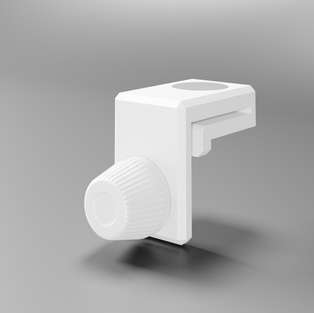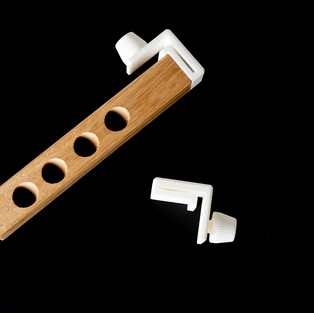Fiume Flipchart: 3D printing combines functionality with minimalist design
- Tim Heinig

- Apr 2
- 5 min read
In an iterative development process, we realized the customer's vision and initiated cost-effective production of the product using additive manufacturing.


Product developer Yannick Fiume places great value on design, individuality, and precision in his products. The flipchart he designed had to embody these values as well. A key component of the flipchart is the sheet holder, which holds the writing pad and provides a quick-access storage location for pens. To develop and manufacture a customized and unique holder, he turned to Süß & friends.
"Look and feel are paramount in my projects. Especially when outfitting event venues and conference rooms, I was always bothered by work tools like flipcharts and metaplan boards. They were bulky, unsightly, and complicated to store and transport. My idea was to design a flipchart that not only combines multiple functions and enhances the space as an object, but also eliminates storage and logistics problems. I wanted to break new ground with the sheet holder and, through new processes that Süß & friends specialize in, have the opportunity to realize a great design at a reasonable price." - Yannick Fiume (Product Designer)
In addition to appearance, functionality and cost-effective production were also important to the designer. To facilitate rapid communication on the blade mount design and early functional testing, rapid prototype production was crucial. Additive manufacturing processes and fast digital processes are ideally suited to the customer's requirements.
Iterative development process crucial for success
From the very beginning, it was clear that constant communication with the designer and thus iterative product development would be crucial for the rapid realization of this product. During an initial meeting, we shared design ideas with the client and sketched initial product concepts. Based on technical and aesthetic requirements, we selected a suitable manufacturing process and material. We then converted the sketches into a digital data model in the CAD system. From the very beginning, we ensured that the product was constructed according to the process to ensure high print quality.
Using renderings of the product, the designer was involved in the design process right from the start. Working in the cloud, Mr. Fiume was able to view a current 3D model of the product at any time, even on the go, on any internet-enabled device, thus actively participating in the development process. Design changes could thus be quickly incorporated into the development process. This process not only saved us time but also money. After the first digital version of the bracket was finalized, we began manufacturing the first physical prototype.
The prototype was produced on the Inkspire from Zortrax. This printer uses Digital Light Processing (DLP) . We used Resin Basic, also from Zortrax, as the material. Due to the high surface quality (up to Rz=3) and dimensional accuracy, this material and the DLP process are ideal for design prototypes and demonstration models. Following the printing process, we mechanically reworked the prototype to remove the support structures required for the process and to bring out the elegant surface texture. After just two days, the customer had their first physical model in their hands. This was an important step because, unlike a rendering, it allowed them to experience and test the feel and visual effect of the sheet holder on the flipchart.
The holders slide onto the powder-coated sheet metal of the flipchart. This allows for freely adjustable hole spacing, making them compatible with many flipchart pads on the market. The clamps have two hooks on the front for attaching the pad. The magnet on the top of the product allows the clamp to be securely attached to the back for whiteboard mode.
Minimalist design leaves no room for compromise
In a workshop following an initial iteration, we worked with the product developer to develop further optimization approaches. During testing of the prototype, the desire for compatibility with flipchart pads from all manufacturers arose. Furthermore, the holder's hooks and the groove for mounting the screws stood out too much from the design of the rest of the flipchart. Due to the otherwise very minimalist design with smooth surfaces, the groove for mounting the screws stood out. Together with the customer and with the help of hand-drawn sketches and digital 3D models, we developed the second concept for the holder. The hooks of the sheet holders were replaced with a screw connection. The screw clamp ensures that each pad is securely and non-slip, regardless of the number of sheets on the pad. In addition, the spacing of the hooks on the pad holder is no longer limited, significantly increasing the selection of compatible pads. We replaced the previously visible mounting screws that secure the pen holder with a single screw, which is concealed by the magnet. This makes the entire surface of the holder smooth and underscores the minimalist design. The fine shape of the screw cap, which secures the sheet, rounds off the previously angular contour and aligns it with the design philosophy of the rest of the flipchart. One challenge was developing the thread, which had to be easily tightened and adapted for production using additive manufacturing processes. For these reasons, we opted for a trapezoidal thread and optimized the fit for the manufacturing process. The screw cap is manufactured together with the holder as a single component and separated after printing. By simplifying the manufacturing process and making optimal use of the available build space on the printer, we were able to keep production costs low.
Working in the cloud also allowed for communication about details while the design process was already underway. We also produced a prototype of the second concept using the DLP process. The customer was already very satisfied with this prototype. The next, final version of the product was completed just a few hours later.
Start of series production
For the final version of the product, we chose selective laser sintering as the process. Polyamide (PA12) is used as the material. This allows us to combine high precision with good mechanical properties. The light surface texture gives the component a high-quality appearance and a pleasant feel. The process does not require any support structures, and the clamps can be inserted directly without any post-processing.
Functionality combined with good design is not a contradiction in 3D printing
With the help of additive manufacturing processes and our agile working method using cloud-based design software, we were not only able to implement a rapid iteration process but also initiate series production of the product cost-effectively and quickly. 3D printing enabled us to quickly present functional prototypes to the customer, giving them new design freedom and producing the flipchart clips cost-effectively. Combining functionality with a minimalist design is not a contradiction in terms when it comes to 3D printing.
"With Süß & friends, we have found an irreplaceable partner in the field of prototyping. Thanks to their high level of expertise and manufacturing capabilities, process chains are shortened enormously, thus significantly accelerating the process. Their creative approach never ceases to amaze us." - Yannick Fiume (Product Designer)
In the specialist magazine ALL3DP has already published a post about this project titled " Case Study: 3D Printing For Prototype & Production. " 3D printer manufacturer Zortrax also reported on the flipchart clamp on its blog .
Interior designer Yannick Fiume's flipchart is now a successful product on the market. Further information about the company and the product can be found here .








































